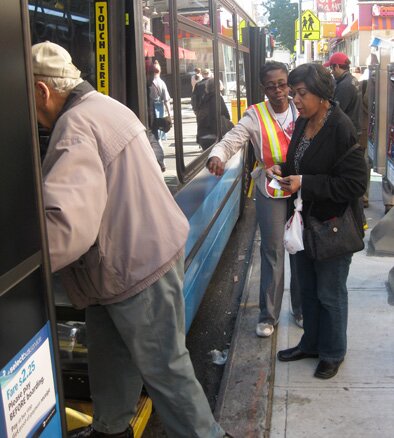
Bus passengers in New York, NY. Source: Noah Kazis, Streetsblog New York, streetsblog.org
New York City Department of Transportation (NYCDOT) wanted to create a transit-friendly review process for proposed projects that better recognized the transportation efficiency of buses. So NYCDOT worked with the Mayor’s Office of Environmental Coordination to require person-delay calculations for proposed transportation or land-use projects that affect bus lanes.
The new requirements were written into the 2010 City Environmental Quality Review (CEQR) manualiThe City of New York Mayor's Office of Environmental Coordination. Chapter 16: Transportation. 2010 CEQR Technical Manual. and carried into the 2012 CEQR manual. The manual also specified that if a bus lane decreases the person delay at an intersection, adding a bus lane can be used to mitigate a project’s potential traffic impacts.iThe City of New York Mayor's Office of Environmental Coordination. Chapter 16: Transportation. 2010 CEQR Technical Manual. The new evaluation criteria gave both developers and the City a more nuanced means of judging the potential impacts and benefits of proposed projects.
The NYCDOT calculates person delay for transit riders by using intersection-based average vehicle delay and multiplying it by the number of vehicle occupants passing through that intersection. To determine the existing number of transit passengers traveling through an intersection, the NYCDOT first figures out the number of buses operating on that street. In New York City, MTA New York City Transit (NYCT) and/or MTA Bus schedules are publicly available. The information specifies how many buses on each route travel through the intersection during the analysis hours. The number of buses on each route is then multiplied by the average number of passengers on that route at that time. Occupancy should be determined for each route, as ridership levels may vary by route. NYCT and MTA Bus occupancy levels can be found from recent ride checks or point checks. The frequency and types of other buses should also be measured during analysis hours.iBeaton, Eric. NYCDOT Director of Transit Development. Personal correspondence. October 4, 2011.
The number of passengers should be multiplied by the average vehicle delay experienced by the lane group in which the bus is traveling. In the build case, the projected number of buses per hour by route should be multiplied by the projected average number of passengers on that bus by route. That number of passengers should then be multiplied by the average vehicle delay experienced by the lane group in which the bus will be traveling. To calculate the person delay for general vehicle traffic, multiply the average vehicle delay for each lane group by an estimate of vehicle occupancy, which can typically be obtained from a metropolitan planning organization or by observation.iBeaton, Eric. NYCDOT Director of Transit Development. Personal correspondence. October 4, 2011.
 Get The Book
Get The Book